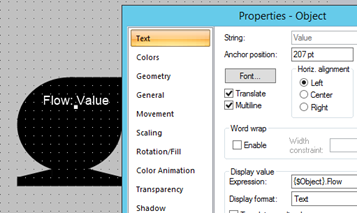Referencing Data in CimEdit Screen Animations
You can use the following two methods to reference data in CimEdit screens that will work in Web HMI mimics.
| Method | Description |
|---|---|
| Method 1 | Continue to directly reference your CIMPLICITY point database in your animations – This method retrieves data directly from CIMPLICITY and shows the values of the points in the database. This is often useful when referencing data that is global to or outside of the model context you build in Web HMI. For example, OverallPartCount. |
| Method 2 | Reference model context-based data that resolves in accordance with the model context you are in when you display the mimic in Web HMI. This is the most powerful way to use Web HMI mimics because it allows you to create screens as templates using CIMPLICITY’s existing local variable mechanisms that resolve at Web HMI runtime. For example, if you have created a Web HMI object type to represent a pump and created 2 pumps objects from that type, you can build one screen in Web HMI to represent the pump object type, and then have the data resolve and appear in that screen/mimic based on the Pump instance that is selected. |
You can reference both direct CIMPLICITY database points and context references in the same screen.
Use the $OBJECT local variable to reference context-based data. You must define this variable at the screen level and leave the value blank when you export the screen as a mimic for Web HMI. You can use this local variable to represent the model context with which this screen is displayed. For example, a pump screen is shown when in the Pump01 or Pump02 context.

Example 1: Referencing Contained/Child Model Object Variables
When in the Inlet pump context, the animation shown below displays the value of Inlet Pump’s flow. If on the Outflow Pump context, this same screen will show Outflow Pump’s flow.
$Object.Flow

Example 2: Referencing Contained/Child Model Object Variables
You can also reference contained object properties in your Web HMI mimics that will be exported from CimEdit. For example, if I want to build an overview screen to show two pumps in my pump station, then I can build a CimEdit screen where the $Object represents PumpStation01 and I reference my animations to show the individual pump values as follows:
{$Object}.InletPump.Flow
{$Object}.OutflowPump.Flow
Example 3: Referencing CIMPLICITY Point Attributes in Web HMI Example
You can continue to reference CIMPLICITY attributes like engineering units, description, alarm limits, and so forth, in Web HMI screens on direct point references and model context references as follows:
{$Object}.Flow.Description or
{$Object}.InletPump.Flow.EU_LABEL
Using Linked Objects to Generate Web HMI Screens
In order to build Web HMI screens using linked objects, any Linked Object local variables that are used to reference Web HMI Object variables must eventually resolve back to the screen $Object variable in which they are placed. When you create the source of a linked object, you create a public “$Object” local variable in your source group object. Use this $Object local variable to reference Web HMI model variables.
For example:
{$Object}.Flow
When you create a linked object from this source group object, you set the value of the inherited $Object local variable to point to the screen $Object defined in the screen in which you created the linked object using local variable syntax like {..\$Object} or {..\$Object}.InletTank”




